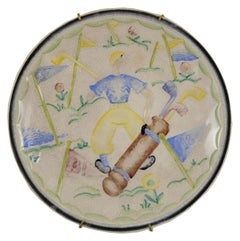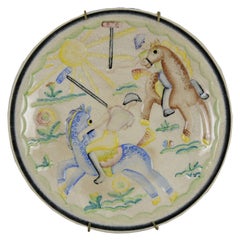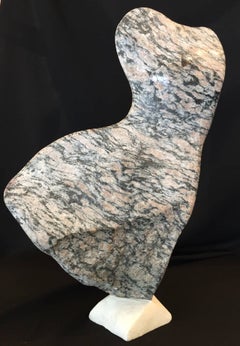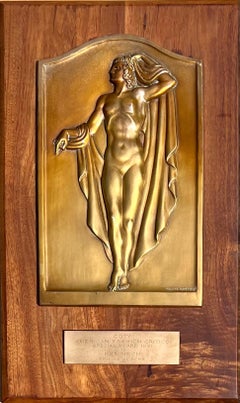Viktor Schreckengost Sculptures
American, 1906-2008
The son of a commercial potter in Sebring, Ohio, Viktor Schreckengost learned the craft of sculpting in clay from his father. In the mid-1920s, he enrolled at the Cleveland School of Art (now the Cleveland Institute of Art, or CIA) to study cartoon making, but after seeing an exhibition at the Cleveland Museum of Art he changed his focus to ceramics. Upon graduation in 1929, he studied ceramics in Vienna, Austria, where he began to build a reputation, not only for his art, but also as a jazz saxophonist. A year later, at the age of 25, he became the youngest faculty member at the CIA. In 1931, Schreckengost won the first of several awards for excellence in ceramics at the Cleveland Museum of Art, and his works were shown at the Metropolitan Museum of Art, the Art Institute of Chicago, the Panama-Pacific Exposition in San Francisco, and elsewhere.
By the mid-1930s, Schreckengost had begun to pursue his interest in industrial design. For American Limoges, he created the first modern mass-produced dinnerware, called Americana. Along with engineer Ray Spiller, Schreckengost designed the first-cab-over-engine truck for Cleveland's White Motor Company. By the end of the decade, he had designed the first Mercury Bicycle for Murray, Ohio. In 1939, the bicycle and "The Four Elements" in clay were displayed at the New York World's Fair.
In the 1940s, Schreckengost's designs for children's pedal cars (as well as bicycles and toys) helped Murray, Ohio become the world's largest manufacturer of pedal cars. His design and ceramic work was interrupted by World War II, when he was recruited by the Navy to develop a system for radar recognition that won him the Secretary of Navy's commendation.
After the war, Schreckengost resumed his industrial design career creating products for Murray, Sears, General Electric, Salem China Company, and Harris Printing, among others. Approximately 100 million of his bicycles were manufactured by Murray, making it the largest bicycle-maker in the world. He retired from industrial design in 1972, but continued teaching at the Cleveland Institute of Art.
Biography from the Archives of askART In June, 2006, Viktor Schreckengost celebrated his 100th birthday in Cleveland Heights, Ohio. Of him at this event, it was written: Viktor Schreckengost, a prolific designer whose works ranging from toys, ceramics and paintings to dinnerware and trucks, have touched countless lives, expects his next inspiration to come at any time. . . (he) always seemed to know what to create by responding to needs---like improving the ride of a child's wagon or making user-friendly tableware with an artistic flair."
To recognize his birthday, more than 130 galleries and museums featured his work the summer of 2006 in a "National Centennial Exhibition" that paid tribute to his legacy that "includes generations of students who became designers who shaped the output of industrial America in the post World-War II era."
In February 2008, Victor Schreckengost died at age 101 at Tallahassee, Florida, where he was spending the winter.to
2
Overall Width
to
Overall Height
to
2
2
1
1
1
1
1
1
2
5
214
210
160
136
2
Artist: Viktor Schreckengost
Golf (Wall Plaque)
By Viktor Schreckengost
Located in Fairlawn, OH
Golf (Wall Plaque)
Polychromed ceramic, c. 1930-1
Signed with the artist's initials: VS recto
Very rare, only a few produced prior to the closure of Cowan Pottery
Format: Round ceramic plate, 11 1/4 inches
Designed by the artist while working for Cowan Pottery in 1930. One of Cowan's clients, an interior designer, requested plates decorated with different outdoor activities. Others in the series included "Swimming," "Tennis," "Polo," and "The Hunt."
According to Henry Adams, the number of examples created was very limited due to the closing of Cowan Pottery in 1931. Very rare
Condition: Good, with the usual craquelure of the glazes used.
Note: Industrial design democratizes high style, and Mr. Schreckengost was widely considered among the most democratic industrial designers. He made, quite literally, the stuff of life — things found routinely in homes, backyards and garages in this country and around the world. He designed bicycles for Sears and everyday china for American Limoges...
Category
1930s Art Deco Viktor Schreckengost Sculptures
Materials
Ceramic
Polo (Wall Plaque)
By Viktor Schreckengost
Located in Fairlawn, OH
Polo (Wall Plaque)
Polychromed ceramic, c. 1930-1931
Signed with the artist's initials: VS recto
Cowan Pottery stamp verso
References And Exhibitions:
Designed by the artist while working for Cowan Pottery in 1930. One of Cowan's clients, an interior designer, requested plates decorated with different outdoor activities. Others in the series included "Swimming," "Tennis," "Golf," and "The Hunt."
Condition: with the usual craquelure
Size: 11 1/4 inches in diameter
Industrial design democratizes high style, and Mr. Schreckengost was widely considered among the most democratic industrial designers. He made, quite literally, the stuff of life — things found routinely in homes, backyards and garages in this country and around the world. He designed bicycles for Sears and everyday china for American Limoges. He designed children’s toys and pedal cars; flashlights, furniture and fans; lawn chairs, lawn mowers...
Category
1930s American Modern Viktor Schreckengost Sculptures
Materials
Ceramic
Related Items
"Female"
By Michael Patterson
Located in Southampton, NY
Wonderful original granite sculpture by well known contemporary artist Michael Patterson. This work of the female form was completed in 2013. The sculpture is attached to a white m...
Category
21st Century and Contemporary American Modern Viktor Schreckengost Sculptures
Materials
Stone
1961 Coty Award Plaque Kenneth Hairdresser Jacqueline Onassis Bronze Fashion
Located in New York, NY
1961 Coty Award Plaque Kenneth Hairdresser Jacqueline Onassis Bronze Fashion
Bronze on wood. The wood plaque measures 12 3/4" by 20 3/4 inches. The bronze plaque itself is 13 3/4 x 8 3/4 inches and the the bronze inscription, which reads "COTY, American Fashion Critics Special Award 1961 to KENNETH of LILY DACHE...
Category
1960s American Modern Viktor Schreckengost Sculptures
Materials
Bronze
$6,800 Sale Price
20% Off
H 21 in W 13 in
"Pioneer Family" WPA American Modernism Plaster Maquette Realism 20th Century
By William Zorach
Located in New York, NY
"Pioneer Family," 23 1/2 x 16 1/4 x 10 3/4 inPlaster. c. 1927. Unsigned. Realism
The Smithsonian has a cast of this sculpture in its collection. Pictured on the cover of “The Sculpt...
Category
1920s American Modern Viktor Schreckengost Sculptures
Materials
Plaster
$31,200 Sale Price
20% Off
H 24 in W 17 in D 11 in
Large George Aarons Terracotta Sculpture Relief Art Deco Plaque WPA Artist
By George Aarons
Located in Surfside, FL
Two Figures (Mother and son)
9" x 17" terracotta sculpture, signed lower left mounted to wood panel, 15 1/2" x 23 1/2"
George Aarons (born Gregory Podubisky, in St. Petersburg, Russ...
Category
20th Century Art Deco Viktor Schreckengost Sculptures
Materials
Wood, Terracotta
$2,200
H 15.5 in W 23.5 in D 1 in
Original ceramic pendant " Vé et Astrology "
By Jean Cocteau
Located in CANNES, FR
Jean Cocteau ( 1889 - 1963 )
Vé and Astrology ceramic's pendant :
Vé : signed underneath White 1ere variant
( Terre blanche en relief ). page 212
Size: 7 x5.5 cm
catalogue rai...
Category
1950s Art Deco Viktor Schreckengost Sculptures
Materials
Ceramic
Elegance, Erté
By Erté
Located in Fairfield, CT
Artist: Erte, Romain de Tirtoff (1892-1990)
Title: Elegance
Year: 1982
Medium: Bronze
Edition: 100/250 Numbered, 12 AP, 9 HC
Size: 15 inches
Condition: Excellent
Inscription: Incised...
Category
1980s Art Deco Viktor Schreckengost Sculptures
Materials
Bronze
Rigoletto, Erté
By Erté
Located in Fairfield, CT
Artist: Erte, Romain de Tirtoff (1892-1990)
Title: Rigoletto
Year: 1988
Medium: Bronze
Edition: 145/375
Size: 19.75 x 18.13 x 5.75 inches
Condition: Excellent
Inscription: Incised wi...
Category
1980s Art Deco Viktor Schreckengost Sculptures
Materials
Bronze
“Adam and Eve”
Located in Southampton, NY
Very rare Art Deco three dimensional terracotta sculpture of Adam and Eve by the Austrian artist, Virgil Rainer. Hand painted by the artist. Signed bott...
Category
1920s Art Deco Viktor Schreckengost Sculptures
Materials
Terracotta, Plaster
Terracotta Panthers Statue by Réne Rochard (1906 -1984)
By Irénée Rochard
Located in Gent, VOV
Panters
An imposing statue of a couple of panters by Irenée Rochard (1906-1884). A fine quality, much sought-after terracotta which was edited by Reveyrolis Paris. Before casting, ...
Category
Mid-20th Century Art Deco Viktor Schreckengost Sculptures
Materials
Terracotta
$4,743
H 13.78 in W 29.93 in D 9.45 in
Barge Toiler -Mid 20th Century Modern WPA Labor Plaster Depression-Era Sculpture
By Max Kalish
Located in New York, NY
"Barge Toiler" by Max Kalish is a Mid 20th Century modern Depression-Era sculpture from his Labor series. The WPA era work is made of plaster.
Max Kalish (1891 – 1945)
Barge Toiler
12 x 8”x 4 inches
Patinated plaster
Signed and monogramed
BIO
Born in Poland March 1, 1891, figurative sculptor Max Kalish came to the United States in 1894, his family settling in Ohio. A talented youth, Kalish enrolled at the Cleveland Institute of Art as a fifteen-year-old, receiving a first-place award for modeling the figure during studies with Herman Matzen. Kalish went to New York City following graduation, studying with Isidore Konti and Herbert Adams...
Category
1930s American Modern Viktor Schreckengost Sculptures
Materials
Plaster
$22,500
H 12 in W 8 in D 4 in
Portrait of boy, terracotta sculpture, 1930s-40s, Giorgio Rossi (1894-1981).
Located in Firenze, IT
Portrait of boy, terracotta sculpture, 1930s-40s, Giorgio Rossi (1894-1981). Tuscan Sculptor.
Terracotta modeled by hand by the artist. Unique piece.
Dimensions: Height 31 cm.
The...
Category
1930s Art Deco Viktor Schreckengost Sculptures
Materials
Terracotta
Polar Bear
By François Pompon
Located in PARIS, FR
Polar Bear
by François POMPON (1855-1933)
An original edition sculpture made in white enameled porcelain biscuit.
Stamped in the paste "S 1927 DN" (S for "Sèvres" – dated 1927 – DN...
Category
1920s Art Deco Viktor Schreckengost Sculptures
Materials
Ceramic
Viktor Schreckengost sculptures for sale on 1stDibs.
Find a wide variety of authentic Viktor Schreckengost sculptures available for sale on 1stDibs. You can also browse by medium to find art by Viktor Schreckengost in ceramic and more. Much of the original work by this artist or collective was created during the 1930s and is mostly associated with the modern style. Not every interior allows for large Viktor Schreckengost sculptures, so small editions measuring 12 inches across are available. Customers who are interested in this artist might also find the work of Tom Binger, Dudley Vaill Talcott, and Stanley Bleifeld. Viktor Schreckengost sculptures prices can differ depending upon medium, time period and other attributes. On 1stDibs, the price for these items starts at $3,000 and tops out at $3,000, while the average work can sell for $3,000.



